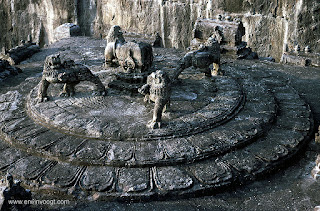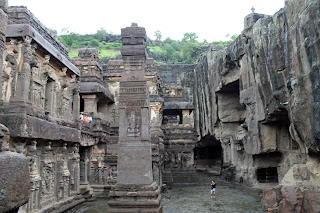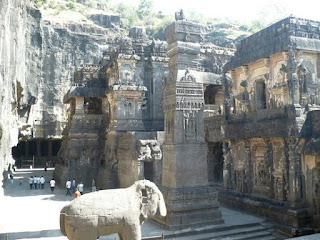The Kailasa (Kailasanatha)
temple is one of the largest rock-cut ancient Hindu temples and is one of the
34 cave (Cave 16) temples and monasteries collectively known as the Ellora
Caves. The speciality of this 1300 year’s old architectural marvel is that it
is built by carving a mountain from a single Rock, of the Charanandri hills at
a village called Ellora, Maharashtra.
The
ancient Indian name for Ellora was Verul Leni. Even now the local people refer
to this place as verul. But Ellora was originally known as Elur or Elapura
since it is located near the Elaganga river, which originates from the nearby
hills. Between the 6th and 11th centuries, armies of
planners, architects, sculptors, smiths and artists were engaged in cutting the
basalt lava rock, which makes up the hills, into 34 temples and monasteries.
The largest monolithic
sculpture in the world carved out of one single rock, Kailasanatha temple is
considered as one of the most remarkable cave temples in India because of its
size, architecture and sculptural treatment.
There are 3 main Gods in
Hinduism. Brahma the God of creation, Vishnu the God of Protection, Shiva the
God of destruction. And this temple is dedicated to Lord Shiva.
The stone carving in India is one of the richest tradition in the world. Guilds of masons and stone carvers
have existed here since the 7th century B.C. The skills were handed down as
family lore from father to son, a practice prevalent in some parts of the
country even today.
The Kailasa Temple is notable
for its vertical excavation, the work started at the top and progressed along
the slope of the mountain, rolling down the large boulders split from the
mountain using steel rod drills. The drill marks are still visible on the
surrounding walls and the technique is used even today in the stone quarries of
Rajasthan. It is important to give a thought to the technique as it would also
suggest the chronology of sculptures. It is clearly visible in all the cave
complexes that the scooping out of the rock is immediately followed by
sculpting. The masons and sculptors work simultaneously.
The classical tradition of
stone carving was closely linked with architecture. All major temples of India (Puri,
Konark, Khajuraho, Kailash Temple, or the Shore Temple at Mahabalipuram) illustrate
the rich tradition of Indian stone carvings.
Kailasa
temple features the use of multiple distinct architectural and sculptural
styles. The temple architecture shows the traces of Pallava and Chalukya
construction styles. It has many resemblances in style and plan with the
Kailasanatha temple at Kanchi and the Virupaksha temple at Pattadakal, but it is
twice the size (, it is approximately 195 feet long, 145 feet wide and 90 feet
tall) and sculpted out of the rock instead of being built with blocks.
T.S
satyamurthi, former archaeologist, explained why the sculptors of kailasa took
the kailaasanatha and virupaksha temples as their models. Since the kailasa
temple was cut out of a rock, from the top to the bottom, the sculptors could
not visualise how deep they could go in the rock formation. They also did not
know whether it was a solid rock formation that continued deep down. So they
used the measurements of the Kailasanatha and Virupaksha temples, as models and
multiplied them for the rock cut at Ellora. When you construct a temple from
the bottom to top you can make changes as you go up and make it more stable. But
when you excavate a temple out of rock from the top to bottom, you cannot make
changes or afford to make mistakes.
But
the modern world doesn’t believe or accept that the ancient Indians could have
risen to such heights of engineering and architectural perfection without the
aid of modern instruments. So they created a theory that this was created by the
beings from outer space (Aliens). And that is why this is the only temple in
the whole complex which can be seen from the sky, but (as an Indian we must
feel that) this statement is an insult to the great craftsmen of India. The
people who say of our ancient Indians who have created such marvels of
construction have no concept of the greatness, will put all our modern
architects, along with their fantastic technology and equipment’s to shame.
It
funny to hear people saying it’s a work of people from outer space, because
what is the purpose of those beings from outer space to make a huge and similar
temple like other temples by human beings, that too on Earth?
There
are episodes from (epics) the Ramayana and the Mahabharata on respective panels
of the temple, how can these be known to beings from outer space?(lol)
There
are two inner courtyards flanking the entry passage. Each courtyard, in the
north and the south, has a gigantic elephant carved out of a single rock. They
also have victory pillars, each about 15m tall. Elephants were the favoured
animal of the Rashtrakuta kings, who are known to have won several battles with
their elephant brigade. Hence the two monolithic elephants signify Rashtrakutha
supremacy, the two free standing pillars of victory further emphasise the great
power of Rashtrakutas.
The
roof of the Mahamantapa has four sculptures of lions, each with a raised paw,
standing in a circle. Some people say these lions from the sky can be seen as a
‘X’ mark and a symbol for beings of outer space, but the unknown truth is these
animated lions are believed to be the guardians of the temple complex(Four
sculptures of lions guarding the four Sides of temple). And some people question that if the temple was excavated by humans, where was the rock removed from the mountain stored? But they don't know about the Bhuleshwar Temple located at Malshiras, Maharashtra which was also constructed by the same type of rock (Black Basalt).
Really, there isn't much
mystery about how it was carved. Following the methods developed from over a
thousand years of manmade caves, it was simply the product of a bunch of men
and their chisels. Finding a nice spot, they began at the top (centre) of a
mountain and worked their way down, every day chipping
stones way. There was no rough forming of the entire temple then going back to
give the details, full detail was carved as they went. Because he masons and
sculptors work simultaneously. Between 400 to 500 men would have worked on it
at one time or so modern estimates go, and it likely took over a hundred years.
Just a bunch of men slowly chipping away. Simple, yes, but no less awesome,
because this is the largest monolithic structure on earth.
The
first and natural series of questions researchers and archaeologists ask when
they discover such an astonishing structure is, when was it built, who built it
and how was it built? They go back to books of history and come up with their
own theories. In reality, if we look at the history from Vedic point of view, nothing
will confuse us. For example, archaeologists go on arguing as to who built
those gigantic and mystical structures around the world, but if they take into
consideration that, according to Vedic scriptures, there have been highly
advanced civilizations in the past, and the size and strength of human beings
in previous ages have been enormous compared to today’s human beings.
But
when we talk about Vedic scriptures or puranas, people call it as Mythology. But
when we think better and broader there will be no word of Mythology. Even
modern scientists are getting closer to accepting Vedic science as an authority
so why not historians and archaeologists? Mythology is introduced by some
foreigners who want to prove us and our ancient engineering and technology was
false and part of myth. We have got our historical evidence from birth to wars
and everything related to these places.
The
Kailasa temple lacks a detailed inscription, but it is clear that it was
commissioned by a Rashtrakuta ruler. Its construction is generally attributed
to the Rashtrakuta king Krishna I (Krishnaraja), based on two epigraphs. The
Baroda copper plate issued in 812-13 CE at a place called Siddhamshi in Gujarat
by Karka Suvarnavarsha (Rashtrakuta King) mentions Krishnaraja as the patron of
Kailasanatha temple (mentions a Shiva temple) at Elapura (Ellora). This copper plate and the Kadamba grant of Govinda
Prabhutavarsha, another Rashtrakuta king, attribute the creation of this
monolith to Krishnaraja I.
 There
is ancient Marathi legend which gives the reason for such a unique
architectural approach. An architect named Kokasa who carved the Kailas temple
in order to please the queen of the Rashtrakuta king of Ellora. The temple was
named Manikeshwara after the queen. It has been proved that Kokasa was indeed
the chief architect of the Kailasa temple as it later came to be called, some
11th-13th century inscriptions from central India mention architects born in
the illustrious family of Kokasa.
There
is ancient Marathi legend which gives the reason for such a unique
architectural approach. An architect named Kokasa who carved the Kailas temple
in order to please the queen of the Rashtrakuta king of Ellora. The temple was
named Manikeshwara after the queen. It has been proved that Kokasa was indeed
the chief architect of the Kailasa temple as it later came to be called, some
11th-13th century inscriptions from central India mention architects born in
the illustrious family of Kokasa.
There
are many rock and cave temples dotted all over India which show the great
knowledge of mathematics, geometry and engineering which our ancient Indians
had. What the modern mind does not understand that these people were not mere
craftsmen in the modern sense who worked only for the pay they would receive at
the end of the day but each one of them must have been an inspired artist who
worked for the sake of art and not for mere pecuniary remuneration. Above all
they must have had complete devotion to God. Their whole mind and hands must
have been dedicated to the service of their beloved Shiva. What is the doubt
that they must have been divinely inspired and helped by Shiva himself? Both the architects who conceived such a
wonder and the sculptors who executed it must have been ardent devotees of
Shiva. When we look at some of the other fantastic Shiva temples in India we
will be forced to conclude that this also must have been designed and executed
by Indian artists and not by people who came from outer space.
When
we have a look at some of the other Shiva temples in India whose design or
construction is unbelievable. Who were these great beings who built these great
temples?
 Consider
the ancient Lord Siva temples from Kedarnath temple in the Himalayas to
Rameswaram in the South with Kaleshwaram, Sri Kalahasti, Ekambareswar at
Kancheepuram, Thillai Nataraja Temple at Chidambaram are aligned in a
geographic straight line around 79° E 41’54” Longitude. These temples have
existed for thousands of years when there was no satellite technology to
measure latitude and longitude. The distance between Kedarnath and Rameswaram
is 2,383 km. Who can explain how they were placed in the same longitude?
Consider
the ancient Lord Siva temples from Kedarnath temple in the Himalayas to
Rameswaram in the South with Kaleshwaram, Sri Kalahasti, Ekambareswar at
Kancheepuram, Thillai Nataraja Temple at Chidambaram are aligned in a
geographic straight line around 79° E 41’54” Longitude. These temples have
existed for thousands of years when there was no satellite technology to
measure latitude and longitude. The distance between Kedarnath and Rameswaram
is 2,383 km. Who can explain how they were placed in the same longitude?
Siva
has five temples built, representing the manifestation of Linga in 5 elements
of nature named as the Pancha Bhoota - Earth, Water, Fire, Air and Space.
The
temple for water is in Thiruvanaikaval, fire is in Thiruvannamalai , air is in
Kalahasti , earth is in Kanchipuram and The temple for space is in Chidambaram
(clarification of these temples will be given in our next articles).
Speciality
of these five temples is, that they were built according to the yogic sciences,
and are placed in a certain geographic alignment with each other, so that the
entire region reverberated with the possibility they offered, which we are
still unable to gauge and unable to understand how they did it. Surely we
cannot attribute all these miraculous creations to some alien who came from
outer space?
Consider
Thillai Nataraja Temple, Chidambaram as an example which shows the great
knowledge our ancient Indian rishis had about astronomy, astrology and
geometry.
This
is the temple in which we find Shiva as the cosmic dancer with his uplifted
foot and modern scientists have proved that his big toe is the centre point of
the world’s magnetic equator. But how many of you know this had been told to us
by Thirumoolar the great Tamil scholar five thousand years ago. Nobody believed
this but now that modern science has verified this we feel that it must be
true. How did Thirumoolar come to know this and how did the architects who
built the temple know this? Again these are mysteries which we cannot answer
though we have so much of technological knowledge.
The
architecture of the temple of Shiva at Chidambaram is based on the human body
thus showing their knowledge of anatomy. The temple is tilted slightly towards
the right to give place for our heart which is to the left of the lungs. It has
nine entrances corresponding to the nine orifices of our body. The roof is made
of 21,600 gold sheets which denote the 21,600 breaths taken by the human being
in per day. These gold sheets are fixed to the gopuram or Shikara, using 72,000
gold nails which denote the total number of nadis or nerves in the human body.
The nadis transfer energy to those body parts which are invisible. There are
five steps leading to the sanctum which represent the five syllables of the
great mantra of Shiva (na-ma-shi-va-ya). The four pillars holding up the hall
represent the four Vedas.
The golden temple has twenty-eight pillars which
denote the 28 methods of worshipping Shiva. These pillars support the 64 beams
of the roof representing the 64 arts. The cross beams represent the blood
vessels running through the human body. The 9 pots on top of the golden roof
represent the 9 types of energies (shaktis). The 18 pillars in the adjacent
hall represent the 18 Puranas. The dance of Shiva as Nataraja as seen in the
temple denotes the cosmic dance of energy (of protons and neutrons). If our
ancients could have taken all these things into consideration when constructing
this temple why should be doubt their ability to construct a huge monolith like
the Kailasanatha temple in Ellora?
This
type of works require a mind-boggling amount of pre-planning and mathematical
and engineering genius which we cannot even imagine.
The modern humans with their
pride, assume that the ancient humans had no knowledge or skills ? There is no
'NEW" knowledge and it is available to those who " tap into it"
and seek it. Knowledge is revealed but not discovered.
As
far as we Indians are concerned, these mysteries were all possible to our ancient
Indian sages who worked on a platform totally different from ours. We are all
five-sensor beings but they were multi- sensor beings. We use less than 10% whereas
they used 100% of their brain.
We must agree to this that it
was made by human hands only and yes, we had to think out of box, there is
something we are missing or we can say that we have lost that technology with
which it was made.
And we strongly believe that
everything related to our ancient engineering and technology was stored in Nalanda
University which was an ancient centre of higher learning in India. But Nalanda
University was ransacked and destroyed by an army under Bakhtiyar Khilji
in1193. The great library of Nalanda University was so vast that it is reported
to have burned for three months after the invaders set fire to it. This is the time and place
where we lost our ancient but advanced technology
Also Read : History of Kailasa temple
Many people refuse to accept
the role of Islamic invaders in the decline of art, culture, science and
technology in India, while the invaders themselves were proud of their
achievements and clearly explained in their memoirs.
Just imagine, if
ISIS reaches Europe, destroys Vatican, burns all the libraries, destroys
Oxford, Cambridge, Stockholm University and all other universities what will
remain of Europe? It will lead to the belief that Europe never existed. The
same happened to us, over and over with each Islamic invasion and today because
of this we are suffering from a word called Mythology.











0 Comments